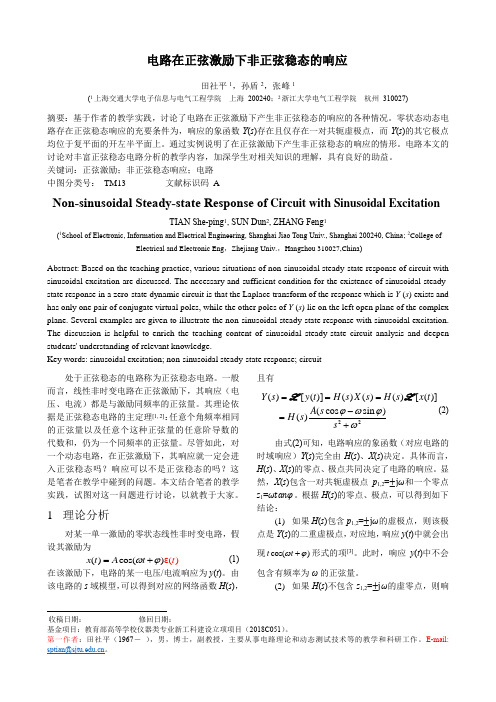第十章1非正弦周期激励电路的稳态响应
- 格式:ppt
- 大小:889.00 KB
- 文档页数:32


电路在正弦激励下非正弦稳态的响应田社平1,孙盾2,张峰1(1上海交通大学电子信息与电气工程学院 上海 200240;2浙江大学电气工程学院 杭州 310027)摘要:基于作者的教学实践,讨论了电路在正弦激励下产生非正弦稳态的响应的各种情况。
零状态动态电路存在正弦稳态响应的充要条件为,响应的象函数Y (s )存在且仅存在一对共轭虚极点,而Y (s )的其它极点均位于复平面的开左半平面上。
通过实例说明了在正弦激励下产生非正弦稳态的响应的情形。
电路本文的讨论对丰富正弦稳态电路分析的教学内容,加深学生对相关知识的理解,具有良好的助益。
关键词:正弦激励;非正弦稳态响应;电路 中图分类号: TM13 文献标识码 ANon-sinusoidal Steady-state Response of Circuit with Sinusoidal ExcitationTIAN She-ping 1, SUN Dun 2, ZHANG Feng 1(1School of Electronic, Information and Electrical Engineering, Shanghai Jiao Tong Univ., Shanghai 200240, China; 2College ofElectrical and Electronic Eng ,Zhejiang Univ.,Hangzhou 310027,China )Abstract: Based on the teaching practice, various situations of non-sinusoidal steady-state response of circuit with sinusoidal excitation are discussed. The necessary and sufficient condition for the existence of sinusoidal steady-state response in a zero-state dynamic circuit is that the Laplace transform of the response which is Y (s ) exists and has only one pair of conjugate virtual poles, while the other poles of Y (s ) lie on the left open plane of the complex plane. Several examples are given to illustrate the non-sinusoidal steady-state response with sinusoidal excitation. The discussion is helpful to enrich the teaching content of sinusoidal steady-state circuit analysis and deepen students' understanding of relevant knowledge.Key words: sinusoidal excitation; non-sinusoidal steady-state response; circuit 处于正弦稳态的电路称为正弦稳态电路。




第10章周期性非正弦稳态电路的分析
普通的正弦波变化的电路,可以使用简单的数学方法进行分析,但是,对于周期性非正弦稳态电路,就不是那么容易了。
下面,我们就来讨论一
下周期性非正弦稳态电路的分析。
一、用波形独立变换进行分析
首先,我们可以使用波形独立变换(WIT)方法来分析周期性非正弦
稳态电路。
WIT是一种自动模拟方法,可以解决各种复杂的、非线性的、
时变的、非周期的、非正弦的电路分析问题。
它比传统的基于时域的分析
更具有普适性和准确性。
在WIT中,电路状态会以一系列张量的形式表示,并且只需采用基本
的数值技术就可以进行计算。
它也可以用来解决无处不在的电磁干扰(EMI)和相关的系统性能问题。
二、使用小波变换分析
此外,我们还可以使用小波变换(WT)方法来分析周期性非正弦稳态
电路。
WT是一种基于时域的分析方法,可以用来解决各种复杂的时变电
路的分析问题。
WT可以有效的把时变的连续的电路信号转换成离散的域中的信号,
并可以使用这些信号,来进行多趟的变换,从而实现分析周期性非正弦稳
态电路的分析,从而对电路的性能进行调整。
三、使用过零点估计进行分析
除了上面提到的两种方法外。